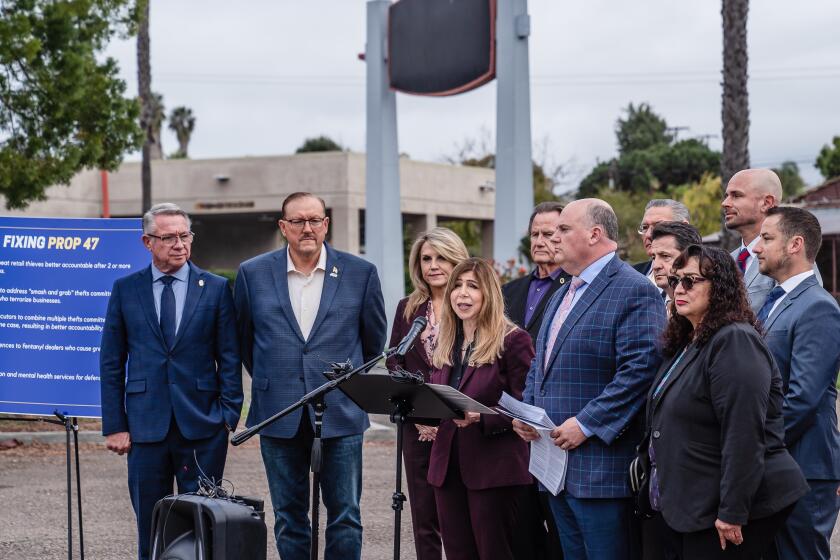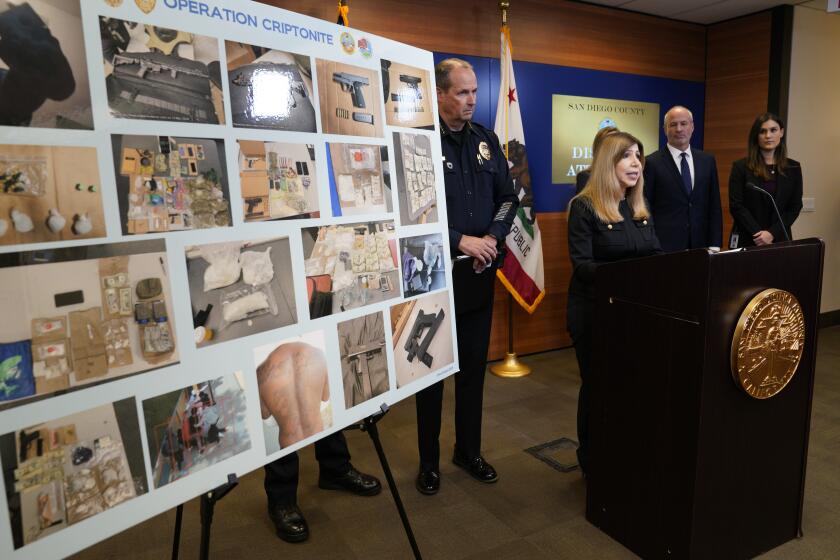San Diego police, county Sheriff’s Department losing officers, deputies faster than they can hire them

Public officials say departments need support, but so do other public safety programs that help prevent crime
The two largest law enforcement agencies in San Diego County are losing officers and deputies faster than they can hire them, a situation police leaders say could negatively impact public safety.
Since the beginning of the current fiscal year, which began in July, the San Diego Police Department has lost about 19 officers a month, compared with about 13 per month in previous fiscal years, according to a staffing report shared with The San Diego Union-Tribune.
This story is for subscribers
We offer subscribers exclusive access to our best journalism.
Thank you for your support.
With about four months left in the fiscal year, 168 officers have left the department, compared with 159 in all of fiscal 2021, 155 in 2020 and 158 in 2019, the report shows.
At the San Diego County Sheriff’s Department, the number of deputies who left in fiscal year 2020 exceeded the total hired by more than 70, and last fiscal year, 28 more deputies left than were hired, department data shows.
This month, the department expects to lose 97 people to retirements — twice the number the department usually sees this time of year, officials said.
Law enforcement leaders say staffing shortages can have short-term and long-term impacts on public safety. It may take officers and deputies longer to respond to emergency calls — and some minor incidents might not get responses at all. Relationships with community members and proactive policing suffer as well, police leaders say.
“The impacts on public safety can be very problematic,” said David Leonhardi, president of the Deputy Sheriffs’ Association of San Diego County. “What if we couldn’t staff our community oriented policing, homeless assistance resource team, or juvenile services units? We have many essential investigative units who do amazing work everyday that don’t make headlines, but it is essential to keeping our communities safe. Our communities would suffer and crime victims feel it the most.”
Across the nation, police departments are struggling to retain officers. Last summer, after a year of large-scale protests demanding police reform, the Police Executive Research Forum found that 194 police agencies around the country saw, on average, an 18 percent increase in resignation rates and a 45 percent increase in retirement rates when comparing April 2019 through March 2020 to the same period a year later.
Several factors are fueling the departures, police leaders and experts said. Some officers don’t feel supported by their communities, as demands for changes to police practices, like those governing when officers and deputies can make stops, continue. Others are choosing to retire because of staffing shortages that consistently require overtime, or constrain time off. Still, others are leaving for jobs that pay more or offer better retirement packages.
After George Floyd was killed in May 2020 at the hands of Minneapolis police, protesters called for police departments to demonstrate greater accountability and transparency, said Cid Martinez, an associate professor at the University of San Diego who specializes in policing.
But that wasn’t all.
Many said they wanted a complete reimagining of public safety, arguing that the current system is inherently racist, which leads to racial profiling, over-policing and use of excessive force — especially in Black and Brown communities. Some demanded that departments be defunded, while others called for getting rid of certain police protections like qualified immunity, which shields officers and deputies who are accused of violating constitutional rights.
“There’s a critical eye on policing in a way we haven’t seen before,” Martinez said. “The public is questioning policing as an enterprise; they’re questioning the fairness of policing. I think officers feel that when they’re out in the field.”
Leonhardi, with the sheriff’s deputies union, said many officers and deputies no longer feel supported by their communities, an experience fueled in part by critical news stories, he said.
“Unfortunately, there’s good reason to believe these challenges are getting worse, not better,” Leonhardi said. “We’re struggling to hire qualified candidates. This is resulting in overworked, stressed out deputies, a vast decline in morale, and significantly more retirements than normal.”
The pandemic likely played a role as well.
San Diego Police Officers Association President Jared Wilson said the city of San Diego’s COVID-19 vaccine mandate was the breaking point for many officers, who already felt underpaid and underappreciated.
“For many people this is the straw that broke the camel’s back,” Wilson said of the mandate.
Many San Diego police officers opposed the mandate when it was announced in August, with some saying they would rather be fired than comply. Most of the police union’s members did, ultimately, get vaccinated, but nearly 475 out of about 1,900 have asked for medical or religious exemptions. The city is still working on evaluating those requests.
Both union presidents said the departures have left their departments stretched thin.
Leonhardi said deputies working in the courts and jails are being required to work two to three overtime shifts per pay period because of the staffing shortages.
Both departments are struggling to staff patrol teams, with some neighborhoods working at or below minimum staffing levels. Leonhardi said deputies in Lemon Grove have stopped responding to some minor calls for service, including some noise complaints and disturbances. These kinds of shortages could slow response times and limit officers’ and deputies’ ability to prevent crime, he said.
“If a patrol team is at minimum staffing, a deputy is unable to take the initiative to go out and search proactively for crime and criminals because if they find something and get occupied, we won’t have anyone available to respond to 911 calls,” he said.
The shortages impact relationships with the community as well, Wilson said.
“When staffing is so low and you’re just responding to calls for service over and over again, you don’t build those relationships,” he said.
Some officers and deputies are choosing to leave their current departments for others that offer better pay, scheduling or retirement packages.
This year, 34 San Diego officers left for other law enforcement agencies. That’s double the number who went to other departments in fiscal year 2021.
Wilson said officers with large agencies like the San Diego Police Department are a “valuable commodity elsewhere” and can easily get jobs at other law enforcement agencies.
Some San Diego police officers were hired in El Cajon, a city without a vaccine mandate and where the City Council added 10 spots to its police force for experienced officers looking to make a career move. The council approved the positions as the deadline approached for San Diego police officers and other employees to comply with the city’s mandate.
El Cajon City Manager Graham Young said the city’s Police Department received applications from 29 qualified candidates, including 22 San Diego police officers and two county sheriff’s deputies.
Wilson said the political climate in San Diego and calls for police reform affect morale, which plays a role in an officers’ decisions to walk away from their jobs.
“Some people are done being big-city cops,” he said, adding that some officers are “done” having things thrown at them during protests or being called racist.
“These things don’t happen in other towns,” Wilson said. “Things like that crush morale.”
During a recent City Council budget committee meeting, San Diego Police Chief David Nisleit alerted council members of the department’s retention issues. He noted that when he joined the department in 1988, the police force had around 200 more officers than today.
“I think everybody understands the city has grown, both in square miles but also in population and complexity of crime and different things like that,” Nisleit said.
As of March 7, the San Diego Police Department had a total of 1,914 officers. The figure is more than 100 short of the 2,036 positions the department has budgeted.
The chief added that the department will lose officers who will be forced to retire under the city’s Deferred Retirement Option Plan, commonly referred to as DROP. Under the program, 85 officers in fiscal 2025 and 83 officers in 2026 will retire.
“It is something we’re paying attention to and is concerning to us,” Nisleit said of the retention issues.
In late January, county Supervisors Joel Anderson and Jim Desmond introduced an agenda item that was meant to address an anticipated shortage of public safety officers in the region. Although the Sheriff’s Department was the focus of the item, the Board of Supervisors ended up unanimously approving a motion that tasked county officials with putting together a report on recommendations related to recruitment, planning and funding strategies for the Sheriff’s Department as well as the Probation Department, Public Defender’s Office and county youth programs.
Supervisor Nora Vargas said during the meeting that while she supported the idea of bolstering recruitment efforts at the Sheriff’s Department, it was equally important to safeguard the county’s many other public safety programs.
“Our criminal justice systems and policing systems need a fundamental change where human, restorative and rehabilitative justice as well as effective public safety are prioritized,” said Supervisor Nora Vargas.
Members of the San Diego City Council also said the city should be investing in crime and violence protection programs alongside police.
Councilmember Monica Montgomery Steppe said police retention is crucial, and noted she supported police recruitment bonuses in the past. San Diego Mayor Todd Gloria also said in a statement that the city has worked to retain officers by investing in training academies, higher wages and pension benefits. But Montgomery Steppe also said that the city needs to start thinking about how other groups, like homeless outreach teams and social workers, can better support police services.
“We need to start to think of ways that can support the department and the duties that some sworn officers have that maybe other folks can pick up,” Montgomery Steppe said. She chairs the city’s Public Safety and Livable Neighborhoods committee and has long championed police reform initiatives.
Both union presidents said departments will need to pay more and offer better retirement packages if they expect to attract the best recruits.
But Martinez, with the University of San Diego, said compensation alone is unlikely to solve some of the more complicated issues that fueled some police departures.
“Funneling money to our police departments is not going to solve the outcry and the demand for transparency and accountability,” he said. “It’s not going to dissolve the pressure that communities are placing on departments.”
The latest news, as soon as it breaks.
Get our email alerts straight to your inbox.
You may occasionally receive promotional content from the San Diego Union-Tribune.







